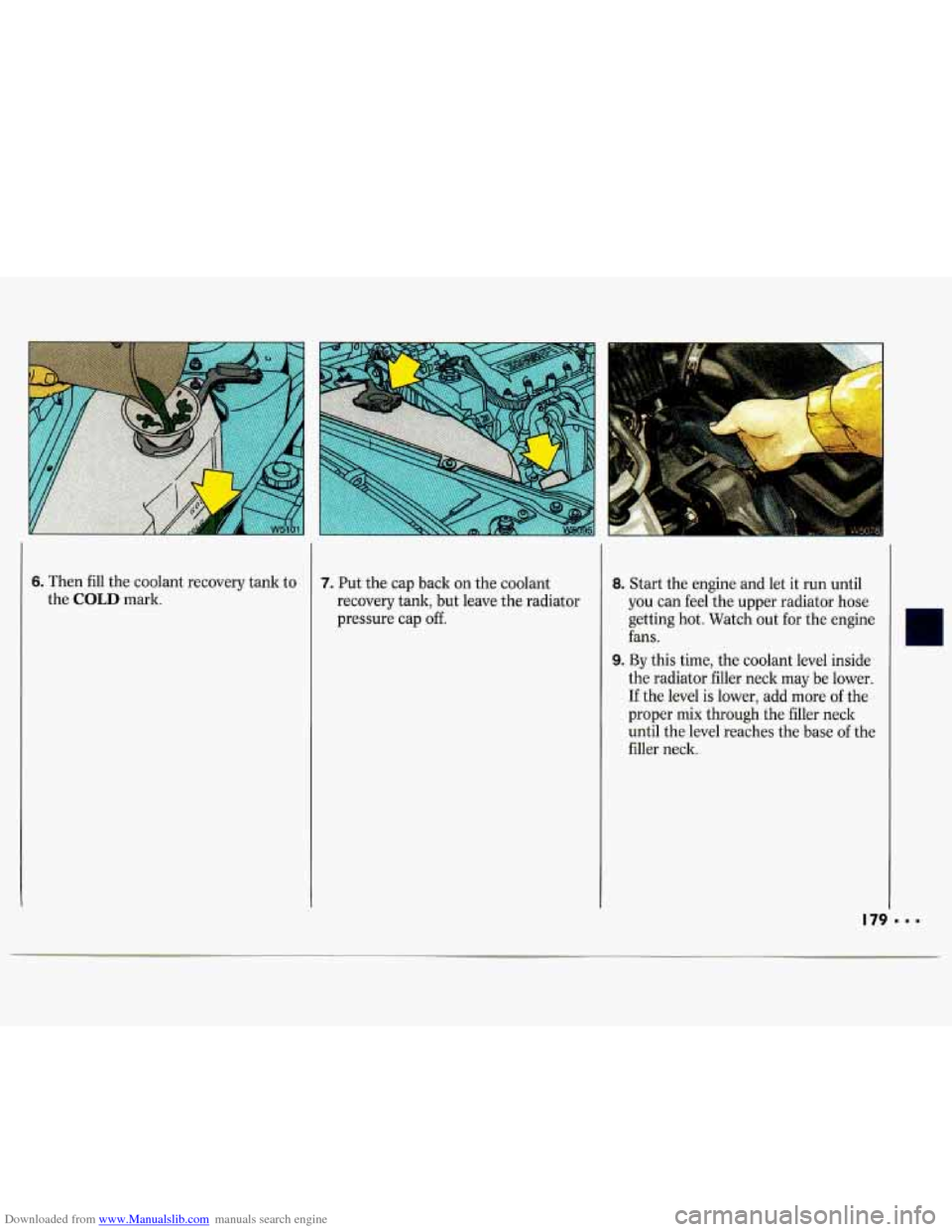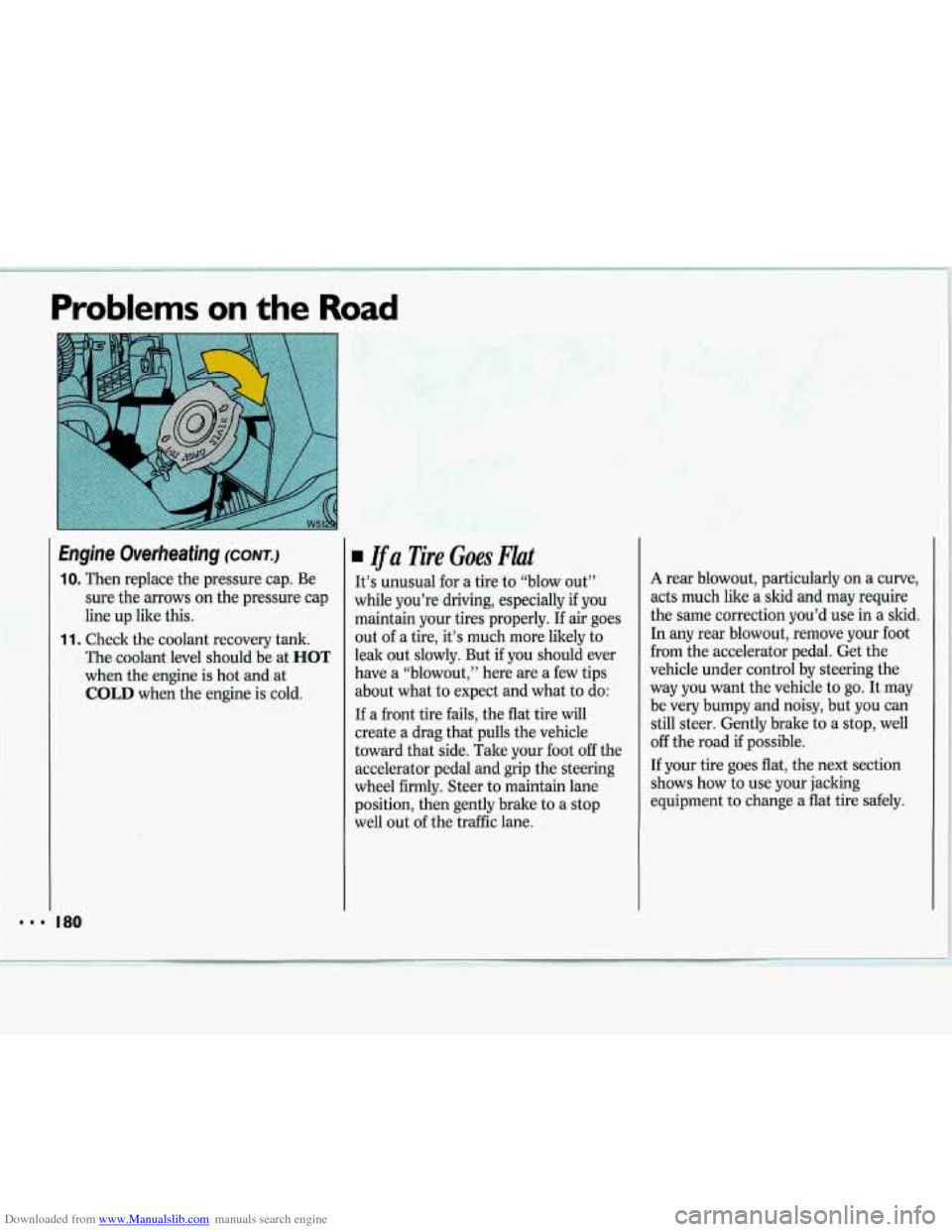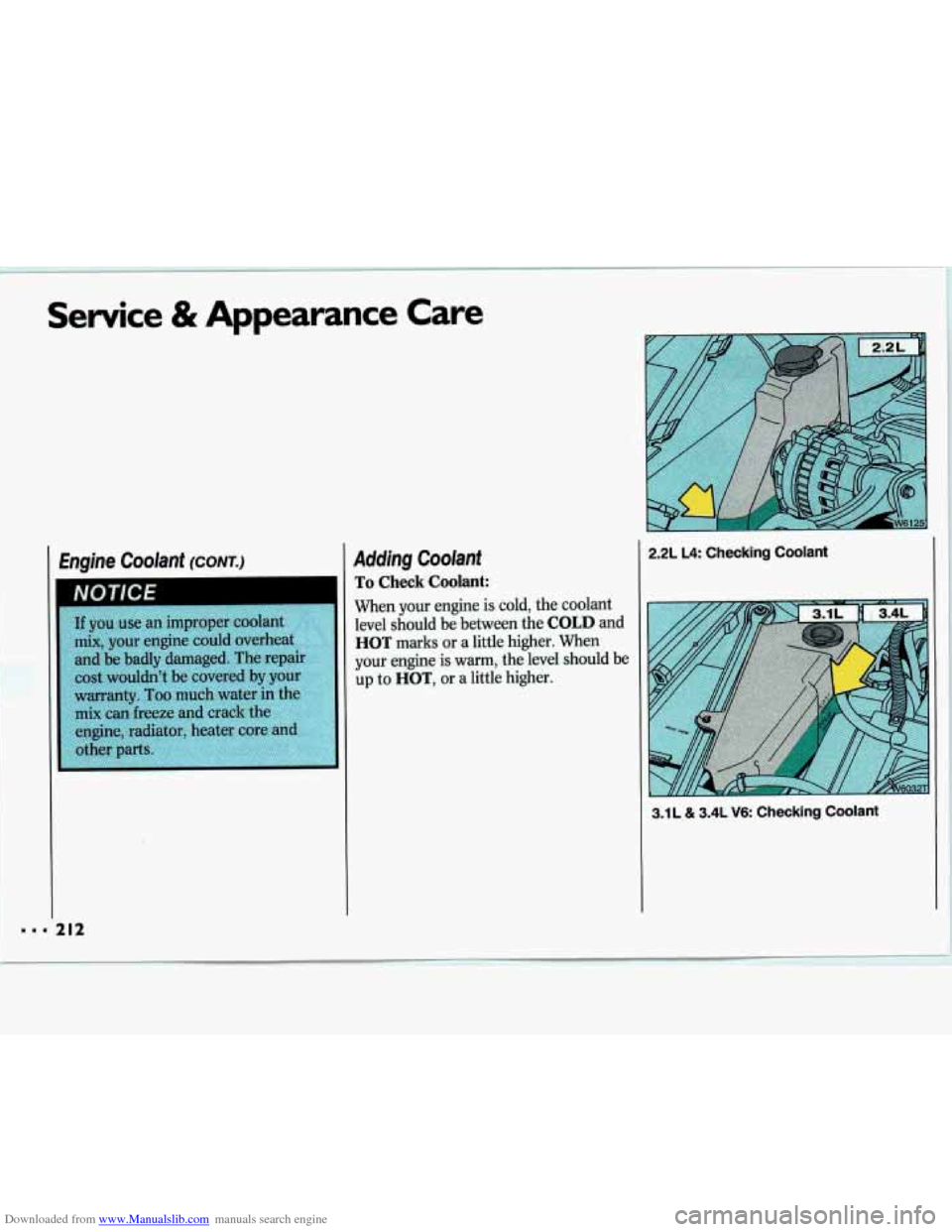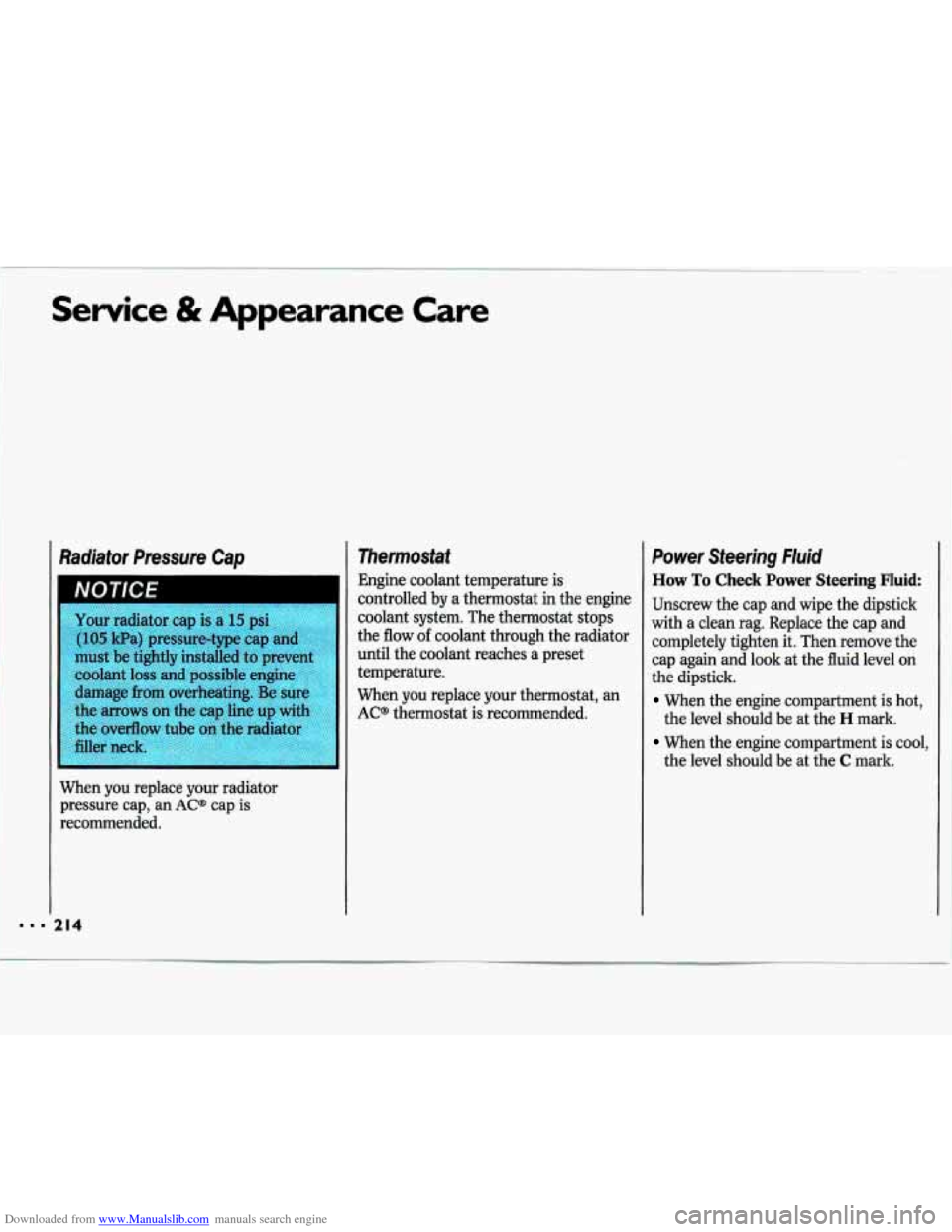1993 CHEVROLET LUMINA coolant level
[x] Cancel search: coolant levelPage 177 of 324

Downloaded from www.Manualslib.com manuals search engine I
The coolant level should be at or above
the
COLD mark.
If it isn’t, you may have a leak in the
radiator hoses, heater hoses, radiator,
water pump or somewhere else in the
cooling system.
Heater and radiator hoses,
L L and other engine parts, can
be very hot. Don’t touch them. If
you do, you can be burned.
Don’t run the engine
if there is a
leak. If you run the engine, it could
lose all coolant. That could cause
an engine fire, and you could be
burned. Get any leak fixed before
you drive the vehicle.
1 NOTlCE CAUTION
If you haven’t found a problem yet, but
the coolant level isn’t at or above
COLD, add a 50/50 mixture of clean
water
(preferably distilled) and a proper
antifreeze at the coolant recovery tank.
(See the
Index under Engine Coolant
for more information about the proper
coolant mix.)
-l
A Adding only plain water to
your cooling system can be
Amgerous. Plain water, or some
~ .ler liquid like alcohol, can boil
before the proper coolant mix will.
Your vehicle’s coolant warning system is set for the proper coolant
mix. With plain water or the wrong
mix, your engine could get too hot
but you wouldn’t get the overheat
warning. Your engine could catch fire and you
or others could be
burned. Use a
50/50 mix of clean
I
I NOTICE
175 .
Page 181 of 324

Downloaded from www.Manualslib.com manuals search engine 6. Then fill the coolant recovery tank to
the
COLD mark.
7. Put the cap back on the coolant
recovery tank, but leave the radiator
pressure cap off. 8. Start the engine and let it run until
you can feel the upper radiator hose
getting hot. Watch out for the engine
fans.
9. By this time, the coolant level inside
the radiator filler neck may be lower.
If the level is lower, add more of the
proper mix through the filler neck
until the level reaches the base of the
filler neck.
Page 182 of 324

Downloaded from www.Manualslib.com manuals search engine Problems on the Road
Engine Overheating (CONT.)
10. Then replace the pressure cap. Be
sure the arrows on the pressure cap
line up like this.
1 1. Check the coolant recovery tank.
The coolant level should be at
HOT
when the engine is hot and at
COLD when the engine is cold.
- i: .:-
Ifa Tire Goes Flat
It’s unusual for a tire to “blow OU~,)
while you’re driving, especially if you
maintain your tires properly. If air goes
out of a tire, it’s much more likely to
leak out slowly. But
if you should ever
have a “blowout,” here are a few tips
about what to expect and what to do:
If a front tire fails, the flat tire will
create a drag that pulls the vehicle
toward that side. Take your foot
off the
accelerator pedal and grip the steering
wheel firmly. Steer to maintain lane
position, then gently brake to a stop
well out of the traffic lane.
A rear blowout, particularly on a curve,
acts much like a
skid and may require
the same correction you’d use in a
skid.
In any rear blowout, remove your foot
from the accelerator pedal. Get the
vehicle under control by steering the
way you want the vehicle to go. It may
be very bumpy and noisy, but you can
still steer. Gently brake to a stop, well
off the road if possible.
If your tire goes flat, the next section
shows how
to use your jacking
equipment to change a
flat tire safely.
Page 193 of 324

Downloaded from www.Manualslib.com manuals search engine H ere you will find information
about the care of your Chevrolet
.
This part begins with service and
fuel information. and then it shows how to check important fluid and
lubricant levels
. There is also
technical information about your
vehicle. and a section devoted to its
appearance care
.
part 6
Service & Appearance Care
Service ........................................................................\
............................................. 192
Fuel
........................................................................\
.................................................. 193
Hood Release ........................................................................\
................................... 196
Engine Oil ........................................................................\
....................................... 201
Air Cleaner ........................................................................\
...................................... 205
Transaxle Fluid
........................................................................\
................................ 206
Engine Coolant
........................................................................\
................................ 211
Power Steering Fluid
........................................................................\
....................... 214
Windshield Washer Fluid
........................................................................\
................ 215
Brakes
........................................................................\
.............................................. 216
Battery
........................................................................\
............................................. 218
Bulb Replacement
........................................................................\
............................ 218
Windshield Wiper Blade Replacement
.................................................................... 224
Loading Your Vehicle
........................................................................\
...................... 224
Tires
........................................................................\
................................................. 225
Appearance Care
........................................................................\
............................. 232
Vehicle Identification Number (VIN)
.................................................................... 239
Add-on Electrical Equipment
........................................................................\
........ 240
Fuses
& Circuit Breakers ........................................................................\
............... 241
Capacities and Specifications 247
Fluids
& Lubricants ........................................................................\
........................ 249
Replacement Bulbs
........................................................................\
......................... 251
Normal Maintenance Replacement Parts
.............................................................. 254
.. ........................................................................\
..........
Page 213 of 324

Downloaded from www.Manualslib.com manuals search engine How to Check
The proper fluid should be added if the
level does not reach the bottom of the
diaphragm when it’s
in place in the
reservoir. See the instructions on the
reservoir cap.
Engine Coolant
The following explains your cooling
system and how to add coolant when it
is low. If you have a problem with
engine overheating or
if you need to add
coolant to your radiator, see the
Index
under Engine Overheating.
The proper coolant for you1 ~ ~ ~ _et
will:
Give freezing protection c, .m to
Give boiling protection up to 262°F
Protect against rust and corrosion.
Help keep the proper engine
Let the warning lights work as they
What to Use:
Use a mixture of one-half clean water
(preferably distilled) and one-half
antifreeze that meets
“GM Specification
1825-M,” which won’t damage ,
-34°F (-37°C).
(128°C).
temperature. should. aluminum
parts. You can
also use a
recycled coolant conforming to
GM
Specification 1825-M with a complete
coolant flush and refill. If you use this
mixture, you don’t need to add anything
else.
I
9
Adding only plain water to
your cooling system can be
dangerous. Plain water, or some
other liquid like alcohol, can boil
before the proper coolant mix will.
Your vehicle’s coolant warning
system is set for the proper coolant
mix. With plain water or the wrong
mix, your engine could get too hot
but you wouldn’t get the overheat
warning. Your engine could catch fire and you or others could be
burned. Use a
50/50 mix of clean
water and a proper antifreeze.
Page 214 of 324

Downloaded from www.Manualslib.com manuals search engine Service & Appearance Care
Engine Coolant (CONT.)
41
Adding Coolant
To Check Coolant:
When your engine is cold, the coolant
level should be between the
COLD and
HOT marks or a little higher. When
your engine is
warm, the level should be
up to HOT, or a little higher.
2.2L L4: Checking Coolant
3.1 L & 3.4L V6: Checking Coolant
Page 216 of 324

Downloaded from www.Manualslib.com manuals search engine Service & Appearance Care
Radiator Pressure Cap
214
Your radiator cap is a 15 psi
(105 Wa) pressure-type cap and
must be tightly installed to prevent
coolant loss and possible engine
damage
from overheating. Be su
the arrows on the cap line up wi
the overflow tube on the radiato
filler neck.
When you replace your radiator
pressure cap, an
AC@ cap is
recommended.
Thermostat
Engine coolant temperature is
controlled by a thermostat in the engine
coolant system. The thermostat stops
the flow
of coolant through the radiator
until the coolant reaches a preset
temperature.
When you replace your thermostat, an
AC@ thermostat is recommended.
Power Steering Fluid
How To Check Power Steering Fluid:
Unscrew the cap and wipe the dipstick
with a clean rag. Replace the cap and
completely tighten it. Then remove the
cap again and look at the fluid level
on
the dipstick.
When the engine compartment is hot,
When the engine compartment is cool,
the
level should be at the
H mark.
the level should be at the
C mark.
Page 271 of 324

Downloaded from www.Manualslib.com manuals search engine ITEM
NO. SERVICE
6 Camshaft Timing Belt Inspection (3.4L Code X
engine only)*-Inspect for cracks, wear or oiliness.
Check tensioner for proper operation. See the
service manual.
(To purchase a service manual,
see the
Index under Service Publications.)
Replace parts as needed.
Cooling System Service*-Drain, flush and refill
the system with new or approved recycled coolant
conforming to
GM Specification 1825M. Keep
coolant at the proper mixture as specified. See the
Index under Coolant. This provides proper freeze
protection, corrosion inhibitor level and engine
operating temperature.
7
8
Inspect hoses and replace if they are cracked,
swollen or deteriorated. Tighten screw-type hose
clamps. Clean the outside of the radiator and air
conditioning condenser. Wash the pressure cap
and neck.
To help ensure proper operation, we recommend a
pressure test of both the cooling system and the
pressure cap.
Transaxle Service-For manual transaxles, fluid
doesn’t require changing.
For automatic transaxles, change both the fluid
and filter every 15,000 miles (25
000 km) if the
vehicle is mainly driven under one or more
of
these conditions:
ITEM
NO.
9
10
11
SERVICE
In heavy city traffic where the outside
temperature regularly reaches
90°F (32°C) or
higher.
In hilly or mountainous terrain.
When doing frequent trailer towing. (With some
models you shouldn’t ever tow a trailer. See the
Index under Towing a Trailer.)
Uses such as found in taxi, police car or delivery
service.
If you do not use your vehicle under any of these
conditions, change both the fluid and filter every
100,000 miles
(160 000 km).
Spark Plug Replacement*-Replace spark plugs
with the proper type. See the
Index under
Replacement Parts.
Spark Plug Wire Inspection*+Inspect for
burns, cracks
or other damage. Check the boot fit
at the coils and at the spark plugs. Replace wires
as needed.
Positive Crankcase Ventilation System
Inspection*-Inspect system for proper function.
Replace any
worn, plugged or collapsed hoses or
seals. Replace valve only if necessary.
269 .